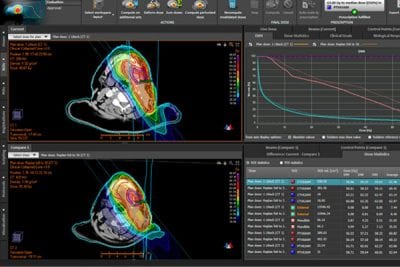
RayStation in action in Cancer Care
Radiation Therapy Cancer Care Services at RBWH has recently treated their first patient with the newly commissioned treatment planning system, RayStation. The new system will replace an older planning system that has been in service since 2006 and will enable the department to progress further with the delivery of cutting-edge treatments.
The commissioning process has taken approximately six months so far and has involved key staff including Radiation Therapists and Medical Physicists. This extensive process ensures data transfer, treatment planning and delivery is maintained to ensure we’re continuing to provide accurate and safe treatment for patients.
RayStation offers some new and exciting functions previously not available on the planning systems in the radiation therapy department. It has the ability to include previously delivered treatment as background information when developing a new plan, and allows for real time evaluation of doses to tumours and critical organs such the spinal cord or kidney.
RayStation also has the functionality to convert a radiation treatment plan developed for a specific treatment machine into an equivalent plan that can be treated on a different machine available within the department. This feature allows for continuity of treatment when an extended break down of treatment machine occurs.
RBWH Director Radiation Therapy Service Gregory Rattray said that with the new RayStation planning system up and running the radiation therapists are eager to explore the full extent of functionality the system provides.
“The system represents an investment in advanced technology that will provide the potential to produce more complex and accurate treatment plans for the patients in our care for many years to come,” he said.
“The system has the potential to automate time consuming functions allowing for faster plan production and reduced wait times for our patients.”